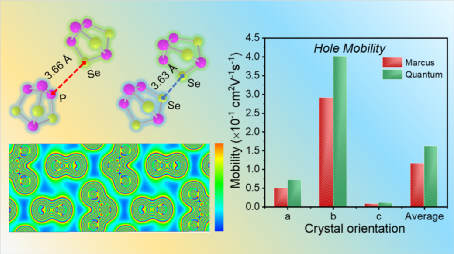On November 15th, a research paper titled “Effect of Strong Intermolecular Interaction in 2D Inorganic Molecular Crystals” was published online inJournal of the American Chemical Societyand was selected as a front cover, which was jointly conducted by Prof. Zhai Tianyou under School of Materials Science and Engineering and Prof. Shuai Zhigang from Tsinghua University together. This paper reveals the effect of strong intermolecular interaction in 2Dinorganic molecular crystalsand provide new theoretic insights into the intermolecular interaction of inorganic molecular crystals, which plays a key role in promoting the development of molecular physics and optoelectronics.

Since graphene wasdiscovered in 2004, two-dimensional materials have become a research hotspot in the whole world. Different from the traditional two-dimensional materials (such as graphene, black phosphorous, etc.) which have strong in-plane chemical bonds and weak van der Waals forces between the planes, two-dimensional inorganic molecular crystals are combined through weak van der Waals forces in all three dimensions. In 2019, professor Tianyou Zhai' group, for the first time, proposed the concept of two-dimensional inorganic molecular crystals (2DIMCs) in the world, which developed a passivator-assisted gas phase synthesis method, and successfully realized the precise synthesis of two-dimensional Sb2O3inorganic molecular crystals (Nat. Commun.2019, 10, 4728), and explored the microscopic process and mechanism of its phase transition. In 2020, this team again designed a vertical microspacing sublimation strategy and prepared two-dimensional inorganic bimolecular crystals (SbI3·3S8), breaking the center-inversion symmetry of inorganic molecular crystal anddemonstrated its application potentials in nonlinear optics (Adv. Mater.2020, 32, 2003146).

The microstructure-properties relationship of molecular crystals is the key of self-assembly into 2D morphology, achieving high mobility and high thermal stability, and exciting new physical properties (Nat. Mater.2020, 19, 491;Nat. Phy.2019, 15, 814). Recently, Prof. Zhai Tianyou under School of Materials Science and Engineering and Prof. Shuai Zhigang from Tsinghua University systematically revealed the effect of strong intermolecular interaction in 2D inorganic molecular crystals. In this paper, first of all, the authors demonstrated the strong intermolecular interaction in2D α-P4Se3induced by unusually short intermolecular Se-Se and P-Se atomic contacts with X-ray photoelectron spectroscopy and other spectroscopy experimental methods. Subsequently, the authors compared the experimental phenomenon of spectroscopy with theoretical calculation results based on quantum nuclear tunneling model, and proposed that physical picture of strong intermolecular interactions can be elucidated as a higher charge density between adjacent P4Se3molecules. Besides, the significant impact of the higher charge density on intermolecular charge transport was clearly revealed, too. Last but not least, the authors further investigated the temperature and phase transition dependence of the strong intermolecular interaction inα-P4Se3and concluded that unusually short intermolecularSe-Se and P-Secontacts are caused by an orderly and close packingof P4Se3molecules, primarily arising from steric effectsproduced by the intermolecular repulsive forces.This work provides new insights into the nature and origin of strong intermolecular interactions in inorganic molecular crystals, which lays the foundation of property control and design of inorganic molecular crystal and will promote the potential applications of 2DIMCs in electronics and optoelectronics.
The work was supported by the National Natural ScienceFoundation of China, the Hubei ProvincialNatural Science Foundation of China and the Fundamental Research Funds for the Central University.Professor Zhai Tianyou of HUST and Professor Shuai Zhigang from Tsinghua University were co-corresponding authors. Doctoral student Feng Xin in HUST and postdoctoral fellow Peng Xingliang in Tsinghua University were both first authors. Meanwhile, Professor Li Huiqiao of HUST and Professor Huang Fuqiang from Peking University also participated in this work.
Paper link:https://pubs.acs.org/doi/abs/10.1021/jacs.1c08030
Group link:http://zml.mat.hust.edu.cn/index.htm
Written by: Feng Xin
Edited by: Han Shiyu
